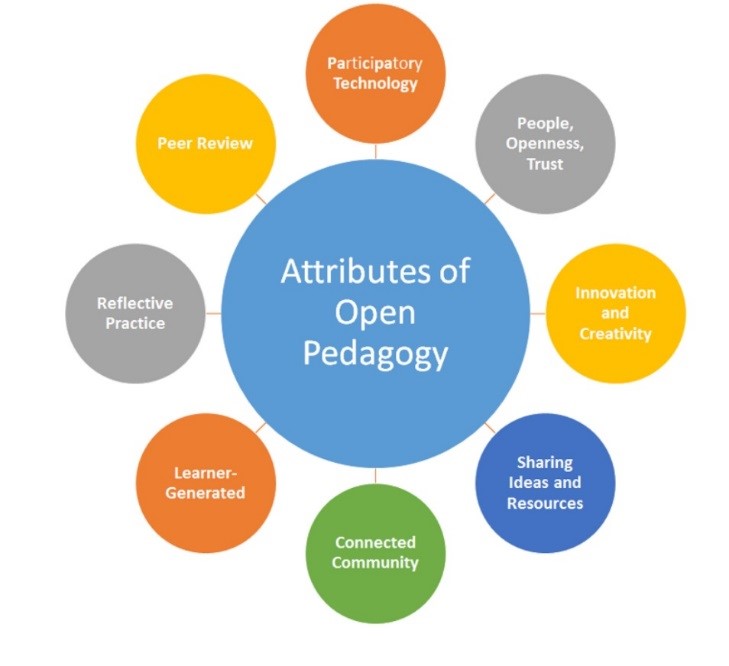6. Open Pedagogy
6.1. What is Open Pedagogy?
David Wiley (2013) originally defined open pedagogy as:
that set of teaching and learning practices only possible in the context of the free access and 4R permissions characteristic of open educational resources
It will be seen later in this section that Wiley has since (2017) recanted on this definition and indeed questions the whole idea of open pedagogy. However, this definition was influential in framing the more recent discussion of open pedagogy around the use of OER (see DeRosa and Jhangiani, 2017, for an excellent discussion about open pedagogy, its origins, and its development since 2013).
Indeed, even in 2019, BCcampus still defined open pedagogy as follows:
Open pedagogy, also known as open educational practices (OEP), is the use of open educational resources (OER) to support learning, or the open sharing of teaching practices with a goal of improving education and training at the institutional, professional, and individual level.
However, it is now realised that for open educational resources to be widely adopted, as well as to change teaching practice, they need to be embedded in a much broader ecology of teaching and learning, of which open pedagogy is a critical component. The following definition from the University of Texas Arlington Libraries represents this thinking:
Open pedagogy is the practice of engaging with students as creators of information rather than simply consumers of it. It’s a form of experiential learning in which students demonstrate understanding through the act of creation. The products of open pedagogy are student created and openly licensed so that they may live outside of the classroom in a way that has an impact on the greater community. Open projects frequently result in the creation of open educational resources (OER). OER are free teaching and learning materials that are licensed to allow for revision and reuse. They can be fully self-contained textbooks, videos, quizzes, learning modules, and more.
I like the above definition because it focuses on student behavior, where open educational materials are a by-product of their learning, rather than the starting point, although open pedagogy can also embrace OER as a starting point.
Hegarty (2015) describes eight attributes of open pedagogy:
- Participatory technologies: Socially constructed media such as blogs, wikis and other ‘sharing’ social media;
- People, openness and trust: Students’ willingness to learn is fragile, with participation and interactions unlikely to flourish unless an element of trust can be built (Mak et., 2010);
- Innovation and creativity: Finding new models of teaching and learning that better exploit OER and more emphasis on choosing digital technologies and methods that encourage the sharing of knowledge and resources;
- Sharing ideas and resources: An open pedagogy needs peers to share willingly within a connected and trusting and professional community;
- Connected community: A technologically linked community with common interests;
- Learner-generated: this requires ‘opening up’ the process to empower students to take the lead, solve problems, and work collectively to produce artifacts that they share, discuss, reconfigure, and redeploy
- Reflective practice: When students and teachers collaborate in partnerships, it facilitates deeper pedagogical reflection
- Peer review: Conole (2014) sees learners as publishers and users of a range of open tools, with peer interactions and critique embedded in the learning experience.
Hegarty also makes the point that it is almost impossible to separate the components of an open pedagogy into neat, segregated dimensions. Components in each of the eight dimensions overlap in many ways.

DeRosa and Robison (2017) set out the key idea of open pedagogy in the following:
By replacing a static textbook — or other stable learning material — with one that is openly licensed, faculty have the opportunity to create a new relationship between learners and the information they access in the course. Instead of thinking of knowledge as something students need to download into their brains, we start thinking of knowledge as something continuously created and revised. Whether students participate in the development and revision of OER or not, this redefined relationship between students and their course ‘texts’ is central to the philosophy of learning that the course espouses. If faculty involve their students in interacting with OER, this relationship becomes even more explicit, as students are expected to critique and contribute to the body of knowledge from which they are learning. In this sense, knowledge is less a product that has distinct beginning and end points and is instead a process in which students can engage, ideally beyond the bounds of the course.
